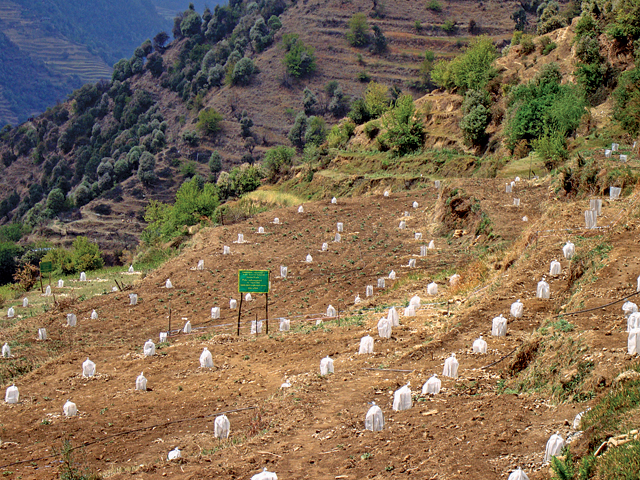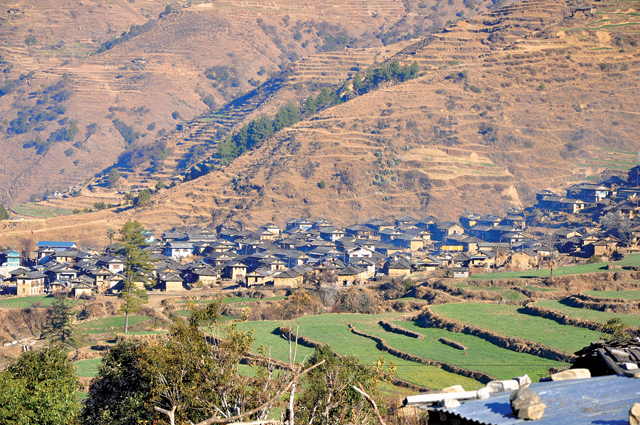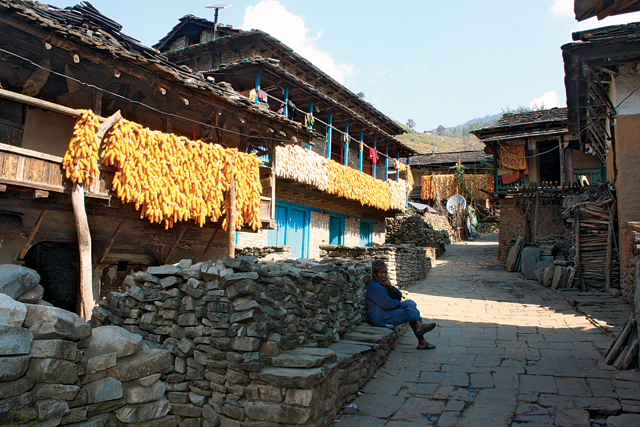Prabesh Roka and Dr. Raj Tripathi are risking five years of hard work. Their Himalayan gamble might pay off lavishly for Nepal. Visionary thinking and innovation are deserving of a country with the world’s most dazzling peaks…and the far-western raaksi is unbeatable.

Prabesh Roka fished out a vial from his rucksack -- crystal clear nectar with a fresh fire-burnished bouquet. This was sweet and feral raaksi (brandy) from deep within the foothills. A mouthful confirmed suspicions – strong, crisp moonshine. The Himalayan ambrosia cleared my senses.
Straightaway, I judged the man by his wholesome firewater -- anyone who offers pure raaksi in Kathmandu is trustworthy by my humble reckoning. Everyone else dilutes it with water to increase volume --softening taste and risking hygiene.
Roka is a former guerrilla in search of a new way of life. His home village of Thabang (Rolpa District) was at ground zero of the ten-year revolution. It experienced the worst of Nepal’s bitter brawl over ideology, class, and control of land and resources—ultimately power. Vicious battles took place where a picturesque village is now reconstructed.
Beyond farming, there is little alternative economy in Thabang. Tourism is slowly picking up in the enchanting hamlet on the southern fringes of the Guerrilla Trek and Yarsa Trails. A few hardscrabble travelers trickle through now and again.

Roka is pouring his energies into high-revenue crops. He convinced the district headquarters to declare the area around the village an organic zone – no farming chemicals allowed. His idealism has led to research on goji berries, goldenseal (a putative medicinal herb), ginseng, and ground apples (also known as jicama) among other sophisticated products.
The raaksi was brewed from Thabang’s ground apple harvest. Roka and I were relaxing at Mahabir Pun’s Connection 
Center. The restaurant overlooks tranquil Mandala Street in otherwise rowdy Thamel. After a few, refreshing gulps of the hearty spirit, I mentioned that it might be an unrivaled bestseller in Kathmandu Valley. Pure raaksi is found in Newar homes (known as ailah) but commercial venues serve a watered-down blend. “We produce 3000 liters a year,” was his amused reply, “and cannot meet local demand in Thabang.” Other than luscious brandy, ground apples are turned into jam, flour, syrup, and crisps.
Roka is now focusing on truffles, edible subterranean fungi worth their weight in gold. Apart from limited cultivation in China, truffles are not grown in Asia. Roka has no illusions, “At their market cost, we will focus on export. It is not practical to eat them in Nepal.”
Dr. Raj Giri Tripathi also has a fascination with this fungus. “They first caught my attention on CNN. I was attracted by the high price and ecological sustainability.” He has a Ph.D. in Genetics from studies in the Republic of Korea. The television report inspired him to raise truffles in Nepal. The lucrative industry is protective of trade secrets -- piece by piece he figured out the truffle puzzle on his own.
He applied for government sponsorship, and no one had a clue what he was going on about -- truffles were a complete mystery. The breakthrough came when then Finance Minister Surendra Pandey was traveling in Europe. Looking through a breakfast menu, his jaw dropped at a price of more than $1000 USD for a truffle-stuffed omelet. Realizing the enormous potential, he phoned Professor Tripathi, “Write a proposal, we will find funding.”
Roka connected with Dr. Tripathi at Tribhuvan University in Kathmandu. Roka’s unassuming demeanor belies a simmering intellect. He speaks gently and directly. “I asked if Thabang had the conditions to raise truffles. He wanted soil for testing.” Climate and conditions including acidity-alkalinity of the topsoil and calcium in the bedrock are among crucial essentials. A dozen soil samples were collected. “One looked promising and the professor wanted the elevation and direction from which sunlight arrived.” The plot adjacent to Thabang synchronized on necessary factors and the professor quickly arranged a field visit.
A pilot project had been initiated in Dolakha District of eastern Nepal. “Conditions have to match both host plant and soil viability,” Dr. Tripathi explains. “The earth needs to be slightly acidic and too much rain can wash acidity out of the soil.” Dolakha receives too much rain. “We began looking west where it is drier. Dolpo had potential but is too remote, and the airport was closed at that time.”
Rolpa District lies south of Dolpo and Rukum districts. Roka and Professor Tripathi joined forces and planted two hectares near Thabang with trees shipped in from the United Kingdom. The imports are hazel, birch and two species of oak. “Nepal has its own varieties of these trees and pine can be suitable, too. The next step is introducing the fungus to indigenous plants to see if it will take to them. Let’s see how this first phase goes. Ultimately, we want to boost local economies to keep people from migrating to miserable work abroad. At the same time, we are encouraging tree planting. When the economy grows and people’s lifestyle increases they are content to stay home. With truffles, the environment benefits, too.”
Initially, fifty trees perished from lack of adaptation to a new ecosystem and perished. After two and a half years, 285 remain strong and healthy. Roka is closely supervising them. Fungi cultured in a lab will be introduced in another six months for colonization in the field. Of three varieties they will try, the winter version known as Black Diamond is potentially the most valuable.
Five years is the minimum period until first harvest. Two and a half years remain before they will know if the trial is successful. It is a long wait, but the gamble might pay off lavishly.
The last time I saw Roka he was dressed casually and low key as on three previous meetings. His unpretentious manner is typical of hill people -- not a shred of showy self-promotion that infests city life and drowns urban dwellers with advertising, fashion, technology and constant attention to social media. Inflated egos have no place in Nepal’s ageless hills and would only get in the way of a rugged lifestyle where the land rewards hard work and innovation.
Roka is unassuming enough that legendary Mahabir Pun did not realize that the soft-spoken fellow drinking a soda next to him was undertaking cutting-edge truffle cultivation (and not just discussing village homestay programs in rural Thabang—which Roka also directs). Pun got Dr. Tripathi’s number from Roka to call the professor and discuss the research rather than ask the other expert in front of him. Roka smiled bashfully, ready to answer questions if anyone cared to ask. Otherwise, he is quietly following his own dreams.
He typifies the best of Nepali character that has long been stifled by bureaucrats with less talent, aid organizations with less know-how, and a societal structure paralyzed by entitlements. When the dormant masses are free -- people with hearts, minds and spirits full of humble love for Nepal -- then the sky’s the limit. At that time, government and non-government organization administrators whose agencies often sink the hopes of millions year after year have to get out of the way -- or facilitate these champions of Nepal as ex-Finance Minister Pandey did. Countrywide prosperity awaits, and visionary citizens like Roka, Tripathi, and Pun are inspiring the way forward.
Creative risk-taking and hard fought accomplishments are deserving of a country with the world’s highest, most dazzling peaks…and the raaksi is unbeatable.








